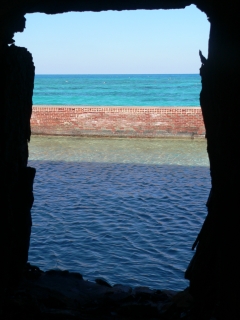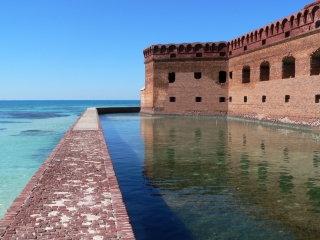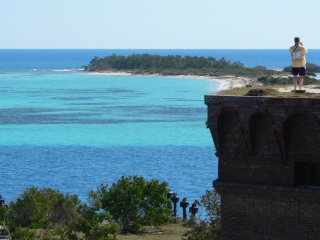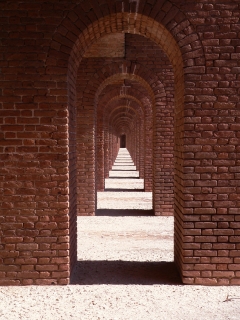NPS Website
 WHAT IS IT?
WHAT IS IT?Seven small islands 70 miles due west of Key West, Florida. Fort Jefferson, one of a string of antebellum coastal forts, stands on one of the islands, Garden Key.
BEAUTY (9/10)
Dry Tortugas NP is in the middle of nowhere, 70 miles away from any human habitation and surrounded by the impossibly blue shallow water of the Gulf of Mexico. The bright turquoise and aquamarine gulf contrasts strongly with the white sand beaches and red brick defenses of Fort Jefferson. The hexagonal Fort’s unfinished inner sanctum is distinguished by its numerous arched entranceways, hallways and roofs.
Broken window edges peek out onto the shimmering waters, begging you to go outside. Above you fly the broad wings of the sinister-looking magnificent frigate bird. The key that borders the Fort, Bush Key, hosts the frigate birds’ only nesting site in the United States. Come February, Bush Key also is home to 80,000 breeding sooty terns and 2,500 brown noddies. These two birds are seen nowhere else on American soil.
The underwater life around the Dry Tortugas teems with tropical fish that have made their home in a living coral reef, in the fragile sea grass and near man-made structures like the Fort’s moat walls and wrecked ships. The water is translucent whether you are on the docks espying a human-sized grouper or braving the cold-ish January weather (water temp. 70 degrees) with your snorkel gear.
HISTORICAL INTEREST (5/10)
The U.S. military began construction on Fort Jefferson in 1846 in order to control navigation on the Gulf Mexico. The fort was never finished and never used for military defense purposes. During the Civil War, the fort was used as a Union military prison for army deserters.
After President Lincoln’s assassination in 1865, Fort Jefferson received its most famous prisoner, Dr. Mudd, the physician who treated and housed assassin John Wilkes Booth. The doctor was pardoned a few years later by President Johnson after treating his fellows prisoners during a Yellow Fever outbreak.
Stories of shipwrecks and pirate treasure naturally circulate regarding these remote Caribbean outcroppings. The boat ride to the islands passes over the site of the largest cache of sunken treasure in modern history. There may be more booty to be found throughout the Gulf, but until then, if you bring a kayak, you can snorkel around the wreck of the three-masted 1875 sailboat, the Avanti.
 CROWDS (8/10)
CROWDS (8/10)The Fast Cat Catamaran carried about 20 people although at full capacity it could probably seat a hundred more. There are benefits to a small group. Plenty of doughnuts and coffee for everyone; lunch was equally bountiful. Fewer people on the small Key meant more room to wander, unobstructed photo opportunities and better odds at getting a dry seat on the back deck of the boat.
EASE OF USE/ACCESS (1/5)
One of the most remote National Park sites in the lower 48 states. Dry Tortugas NP is nearly as close to Key West (70 miles) as is the nation of Cuba (90 miles). Getting to the Tortugas, however, is a much easier prospect. Two Catamaran services leave daily from the Key West marina. The boat ride takes about two hours. Seaplane flights are also available.
If you wish to stay overnight, there are a few of campsites just outside the fort’s walls. Make your plans in advance because the campsites do fill up. If you are not staying overnight, you have only four hours to explore the fort, the rare bird sanctuaries and the coral reef. Choose your time wisely.
CONCESSIONS/BOOKSTORE (2/5)
The bookstore isn’t too shabby considering its remote location. Dr. Mudd and Abraham Lincoln are key characters in the few books offered. Bird, fish and coral guides supplement the shelves. The newest addition to the tiny shop is a miniature Fort Jefferson magnet. At $6, a little pricier than our usual souvenirs, but too nice to resist.
COSTS (1/5)
Entry into the park costs $5 per person, free with the National Parks Pass. Transportation is $110 on the Fast Cat (Sunny Days Concessionaire) and $129 on the Yankee Freedom. The price includes breakfast, lunch, a tour of the Fort and snorkeling gear. There are additional fees if you wish to camp.
 RANGER/GUIDE TO TOURIST RATIO (4/5)
RANGER/GUIDE TO TOURIST RATIO (4/5)Rangers live for weeks, even months on end inside the Fort. They do not give tours of the Fort to boating visitors; the Catamaran companies are contractually obligated to teach the Tortugas history. As a result, there is only one interpretive Ranger on staff. Nevertheless, whenever we had a question, a Park Ranger seemed to be walking or working nearby. It is a small place.
TOURS/CLASSES (3/10)
We enjoyed the anecdotal beginnings of our tour guide’s historical lesson but did not stick around for the remainder. A Park Ranger-led talk may have held our attention, but we are not sure. We had only four hours to explore the fort, take pictures, snorkel, bird-watch and enjoy the perfect weather.
When the campground swells with overnighters, a Ranger leads a candlelight tour of the Fort that includes a few ghost stories. This Ranger activity sounds fun and is yet another reason to camp on the beach.
The Site has a few panels in the room adjacent to the bookstore that cover the area history as well as an eleven-minute introductory film. The displays did not immediately catch our attention and we moved on. A few days after our visit, friends of ours recounted their August trip to Dry Tortugas NP. The weather was so unbearable, 110° and humid, that they spent much of their time in this exhibit room, which was, along with the water, a vital respite from the heat. If you come in summer, you might get to know the exhibits much more than we did.
FUN (9/10)
Great fun. In fact, we probably should have planned an overnight camping trip instead of a day excursion. Four hours wasn’t enough time to explore the Fort, see the birds at the neighboring Bush Key and spend any significant amount of time underwater roaming the coral reef. We had a taste of what Dry Tortugas had to offer and that has left us wanting more.
An overnight camping trip offers a visitor to the Florida Keys something very special – solitude. How great it must feel to watch the boats and seaplanes leave for the day, leaving one to soak in the remaining heat of the day, get in a few more moments of snorkeling and then take the best seat in the house to watch the sunset. You are 70 miles from the nearest anything.
Dry Tortugas NP is a birdwatcher’s dream. It stands as its own bird zone, separate and distinct even from southern Florida and the Florida Keys. This may be the only U.S. soil that some birds touch during their yearly migrations. We didn’t spot any sooty terns. Gab swears she saw a brown noddy. Magnificent frigate birds earned their names by taking over the skies with their massive wing span and soaring flight.
 WOULD WE RECOMMEND? (7/10)
WOULD WE RECOMMEND? (7/10)Key West is a magical place, but can be claustrophobic at times. A trip to Dry Tortugas NP takes you away from the noise of Duval Street and into a rare ecological zone. The journey isn’t cheap, but still a bargain if you are seeking serene settings and a private island in the midst of the over-developed Keys.
We don’t think it’s possible to take a bad picture at Dry Tortugas NP. Every color of blue and aquamarine were represented, made even more brilliant as backdrops to the red brick fort. We were disappointed to get back to the marina before 5:30. We are sure sunset at the Tortugas trumps any evening at Mallory Square.
TOTAL 49/80
www.usa-c2c.com
© 2004-06